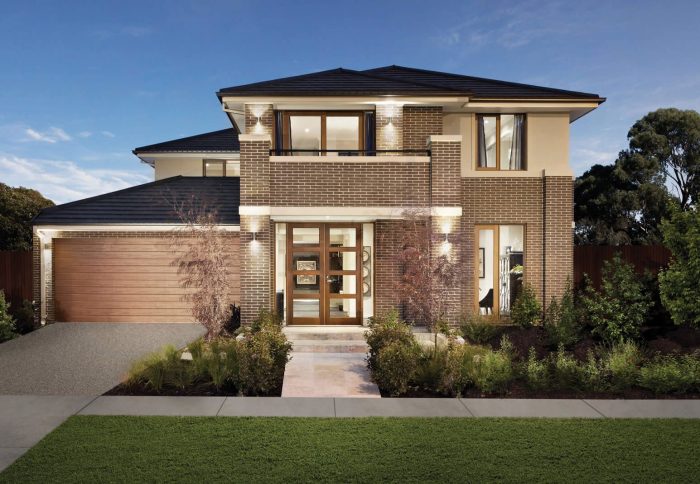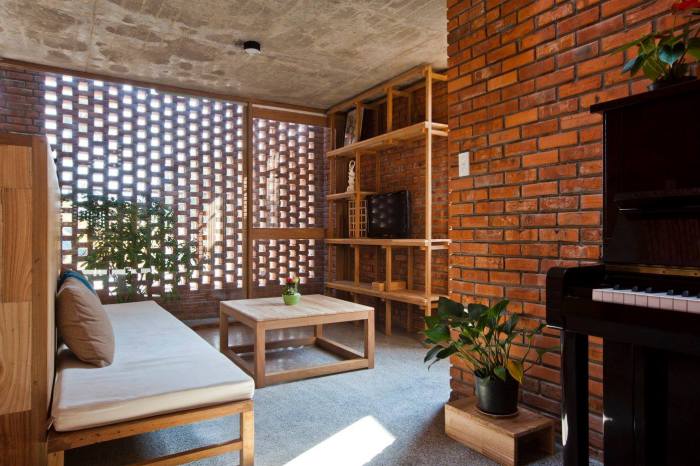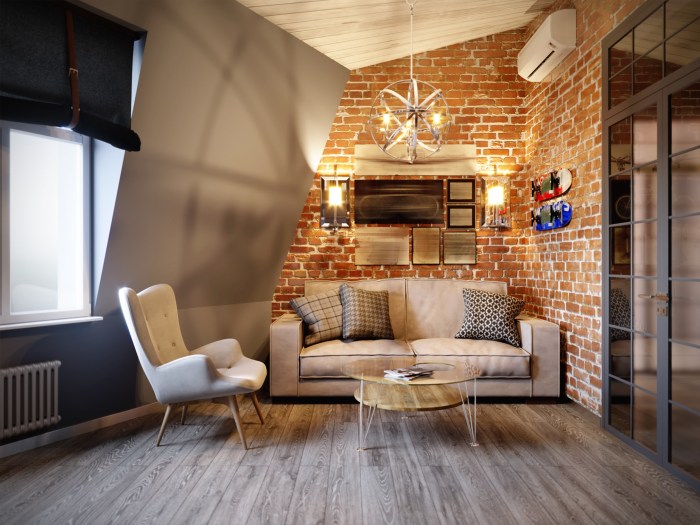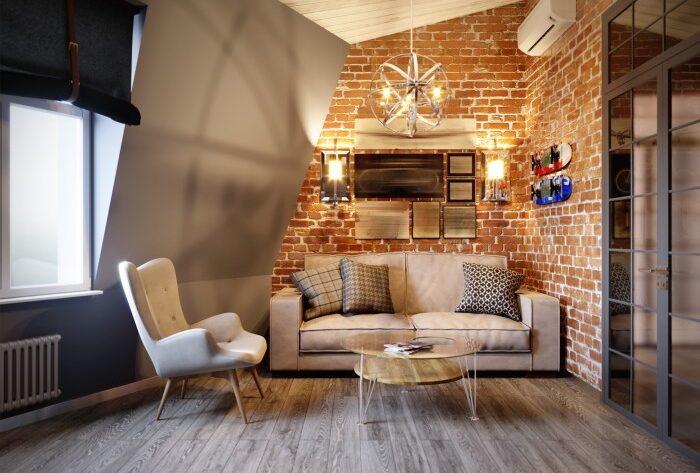Brick house interior design sets the stage for this enthralling narrative, offering readers a glimpse into a story that is rich in detail and brimming with originality from the outset.
Brick houses, with their enduring charm and timeless appeal, offer a unique canvas for interior design. Their sturdy exteriors and often-historic roots present both challenges and opportunities for creating spaces that are both stylish and comfortable. This guide explores the key elements of brick house interior design, from choosing the right color palette to selecting furniture that complements the architectural style.
Brick House Interior Design Overview

Designing the interior of a brick house presents a unique set of challenges and opportunities. Brick, with its inherent warmth, durability, and character, offers a rich backdrop for various interior design styles. However, its inherent characteristics, such as texture and color, require careful consideration to create a cohesive and aesthetically pleasing space.
Historical and Architectural Context of Brick Houses
Brick houses have a rich history, spanning centuries and cultures. Their use dates back to ancient civilizations, with notable examples found in Mesopotamia, Egypt, and Rome. The construction of brick houses evolved over time, with advancements in brick-making techniques and architectural styles.
In the Western world, brick became a popular building material during the Renaissance and Baroque periods, with its use extending into the Victorian and modern eras. The use of brick in residential architecture has varied depending on geographic location, available resources, and prevailing architectural trends.
Brick House Styles and Interior Design Features
Brick houses come in a wide variety of architectural styles, each with its own distinct interior design features.
- Colonial Brick Houses:Often characterized by their simple, symmetrical facades, Colonial brick houses feature interiors that emphasize functionality and practicality. Common design elements include hardwood floors, exposed beams, fireplaces, and built-in cabinetry.
- Victorian Brick Houses:Victorian brick houses are known for their elaborate ornamentation and intricate detailing. Interiors often feature high ceilings, ornate moldings, stained glass windows, and a mix of Victorian furniture styles.
- Modern Brick Houses:Modern brick houses embrace minimalist design principles, often featuring clean lines, open floor plans, and a focus on natural light. Interior design choices typically include sleek furniture, contemporary lighting fixtures, and a neutral color palette.
Lighting and Windows

Brick houses offer a unique opportunity to create a warm and inviting atmosphere, and incorporating natural light and thoughtfully designed window treatments plays a crucial role in achieving this.
Maximizing natural light is a key element in enhancing the ambiance of any home, especially in a brick house. The use of large windows, strategically placed skylights, and light-colored paint can create a bright and airy interior. This abundance of natural light not only brightens the space but also emphasizes the beauty of the brickwork, highlighting its texture and color.
By incorporating these elements, you can create a space that feels welcoming and spacious, while also reducing the need for artificial lighting during daylight hours.
Window Treatments
Window treatments are essential for enhancing privacy and style while complementing the brick architecture. They can transform the look and feel of a room, adding warmth, sophistication, or a touch of whimsy. The choice of window treatments depends on the desired effect and the overall design aesthetic.
- Shutters:These classic window treatments offer a timeless elegance and provide excellent light control. They can be customized in various materials, colors, and styles to match the brickwork and enhance the overall aesthetic. Shutters can be painted in a complementary color to the brick or left in their natural wood finish for a more rustic look.
Their versatility allows for a range of styles, from traditional to contemporary.
- Curtains:Curtains offer a wide range of options for privacy and style. They can be used to soften the harshness of the brick walls, adding a touch of warmth and texture. Choosing curtains in fabrics that complement the brick color and texture can create a cohesive and harmonious look.
For a modern aesthetic, consider minimalist curtains in neutral tones. For a more traditional feel, opt for patterned or textured curtains that add depth and character to the space.
- Blinds:Blinds provide a practical and functional option for light control and privacy. They come in various materials, colors, and styles, allowing for customization to match the brick architecture. For a contemporary look, consider sleek aluminum blinds. For a more traditional feel, choose wood blinds that complement the warmth of the brick.
Blinds can be used in conjunction with curtains to create a layered effect and enhance the overall aesthetic.
Lighting Fixtures
Lighting fixtures play a crucial role in creating a warm and inviting ambiance in a brick house. They can enhance the beauty of the brickwork, highlight architectural details, and create a sense of intimacy and comfort. When choosing lighting fixtures, consider the style of the brickwork and the overall design aesthetic of the home.
For a traditional brick house, consider using fixtures with warm, inviting tones. Chandeliers with crystal accents or wrought iron sconces can add a touch of elegance and sophistication. For a more modern aesthetic, opt for sleek and minimalist fixtures with clean lines and geometric shapes.
Incorporating a mix of lighting sources, such as pendant lights, recessed lighting, and floor lamps, can create a balanced and inviting atmosphere.
Tip:Use dimmable light bulbs to create a cozy and intimate atmosphere in the evening. Experiment with different lighting levels to find the perfect ambiance for each room.
- Pendant Lights:These versatile fixtures can be used in various spaces, from the dining room to the kitchen. They offer a stylish and functional way to illuminate a specific area. Choose pendant lights with a design that complements the brick architecture, such as rustic wood or industrial metal.
Brick houses offer a timeless charm, and their interiors can be styled in a variety of ways. If you’re looking for inspiration, consider drawing from the 1920s house interior design aesthetic, which often features rich colors, geometric patterns, and a focus on comfort and functionality.
These elements can be seamlessly incorporated into a brick house, creating a sophisticated and inviting atmosphere.
Pendant lights can be used in conjunction with other lighting fixtures to create a layered effect and enhance the overall aesthetic.
- Recessed Lighting:Recessed lighting provides a subtle and even illumination, making it ideal for highlighting architectural details and creating a balanced lighting scheme. It can be used in conjunction with other lighting fixtures to create a layered effect and enhance the overall aesthetic.
Recessed lighting is particularly effective in hallways and kitchens, where a consistent level of light is required.
- Sconces:Sconces offer a decorative and functional way to illuminate a space. They can be used in hallways, bedrooms, and living rooms to add a touch of elegance and warmth. Choose sconces with a design that complements the brick architecture, such as wrought iron or brass.
Sconces can be used in conjunction with other lighting fixtures to create a layered effect and enhance the overall aesthetic.
Furniture and Decor

The furniture and decor you choose can either amplify or detract from the unique character of your brick house. Carefully selecting pieces that complement the rustic charm of brick walls and the warmth of natural materials can create a cohesive and inviting ambiance.
Brick houses offer a unique charm and a sense of warmth. The interior design can be enhanced by utilizing the inherent texture of the brick walls, perhaps incorporating rustic furniture or contemporary pieces to create a contrasting style. If you’re working with a smaller space, consider exploring ideas for 700 sq ft house interior design which can be adapted to a brick house.
The use of light colors, smart storage solutions, and multi-functional furniture can maximize space in a brick house, creating a comfortable and inviting environment.
Furniture Styles, Brick house interior design
Selecting furniture that complements the character of a brick house involves considering various styles. Brick houses can accommodate a wide range of furniture styles, from traditional to contemporary.
- Traditional: Embrace the classic charm of a brick house with traditional furniture pieces. Think sturdy, handcrafted wood furniture, plush armchairs, and elegant coffee tables. This style often features intricate carvings, warm wood tones, and rich fabrics.
- Rustic: This style emphasizes the natural beauty of wood and stone. Reclaimed wood furniture, leather seating, and exposed beams create a cozy and inviting atmosphere. Rustic furniture often features distressed finishes and natural textures, enhancing the warmth and character of a brick house.
- Contemporary: For a modern twist, consider incorporating sleek, minimalist furniture with clean lines and geometric shapes. Metal accents, glass surfaces, and bold colors can add a contemporary edge to a brick house interior. However, be mindful of not overwhelming the space with too much starkness.
Brick houses offer a unique charm and warmth, but designing their interiors can be a challenge. The rustic texture of brick walls can sometimes feel overwhelming, especially in smaller spaces. If you’re dealing with a compact brick home, consider incorporating elements from best interior design for small house strategies to maximize space and create a sense of openness.
Using light colors, strategic furniture placement, and clever storage solutions can help you achieve a balanced and inviting ambiance in your brick house.
- Industrial: This style embraces raw materials and exposed structures. Think metal accents, distressed leather, and vintage industrial lighting. This style can add a touch of edgy sophistication to a brick house, especially when combined with reclaimed wood furniture and exposed brick walls.
Decorative Elements
Decorative elements play a crucial role in enhancing the interior design of a brick house. Artwork, rugs, and throws can add personality and warmth to the space.
- Artwork: Select artwork that complements the style and color scheme of your brick house. For a traditional setting, consider paintings featuring landscapes, still lifes, or portraits. Rustic interiors can benefit from artwork with natural themes, such as wildlife prints or abstract landscapes.
Contemporary art, such as abstract paintings or sculptures, can add a modern touch to a brick house.
- Rugs: Rugs can add warmth, color, and texture to a brick house interior. Choose rugs that complement the furniture and decor, while also enhancing the overall design aesthetic. For example, a traditional brick house could benefit from a Persian rug with intricate patterns and vibrant colors.
A rustic setting might feature a wool rug with a simple design, while a contemporary space could incorporate a geometric rug with bold colors.
- Throws: Throws can add a touch of warmth and comfort to a brick house interior. Choose throws that complement the color scheme and texture of your furniture and decor. For example, a brick house with a traditional style could feature throws made of velvet or chenille.
A rustic setting might incorporate throws made of wool or fleece. Contemporary spaces could benefit from throws with bold colors and geometric patterns.
Wrap-Up
Designing the interior of a brick house is a journey of creativity and practicality. By embracing the unique character of these homes, you can create spaces that are both beautiful and functional. From the warmth of natural materials to the play of light and shadow, every detail contributes to a cohesive and inviting atmosphere.
Whether you prefer a traditional or contemporary aesthetic, the possibilities for brick house interior design are truly endless.
User Queries: Brick House Interior Design
What are some common brick house styles?
Brick houses come in a variety of styles, including Colonial, Victorian, Tudor, and Craftsman. Each style has its own unique features and architectural details that influence the interior design.
How do I choose the right color palette for my brick house?
Consider the color of the brick, the amount of natural light, and the overall style you want to achieve. Warm brick tones pair well with neutral colors like beige, cream, and gray, while cooler brick tones can be complemented with bolder hues like navy blue or emerald green.
What are some tips for incorporating brick accents into my interior design?
Brick accents can be used to create a focal point, add texture, or enhance the warmth of a room. Consider using exposed brick walls, brick fireplace surrounds, or brick-inspired tiles in your design.




